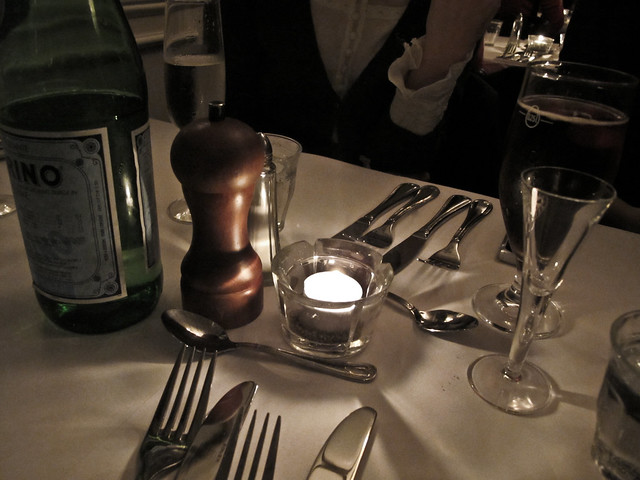Dining Manners and Etiquette – How To Use Your Knife and Fork Abroad
I just spent the evening ruining a perfectly good hamburger while trying to re-learn how to use my knife and fork. In an effort to immerse myself more completely during my time in Europe and Scandinavia I’m starting to try and eat like a European. Unfortunately, that means awkwardly using my knife and fork, throwing a chunk of my traditional American table manners out the window, and desecrating – yes I said desecrating – hamburgers.
If you’re planning a trip to Europe and are from the US one key (but subtle) difference to prepare for is how you cut and eat your food. For those of you raised to eat in the European/Continental style this won’t be an issue for you. If, like me, you were raised using the American style you’re in for a bit of an adventure and this post is for you.
First, let’s get back to basics. Just what are the American and Euro/Continental styles that I’m talking about? They’re two different approaches for using your knife and fork during a meal. While you’ll encounter other cultural differences in the way a table is set and what is considered polite the use of your knife and fork is one of the most blatant cultural faux paus Americans make while dining abroad. Let’s take a look at the styles via wikipedia:
The American style
In the American style, also called the zig-zag method, the knife is initially held in the right hand and the fork in the left. Holding food to the plate with the fork tines-down, a single bite-sized piece is cut with the knife. The knife is then set down on the plate, the fork transferred from the left hand to the right hand, and the food is brought to the mouth for consumption. The fork is then transferred back to the left hand and the knife is picked up with the right. In contrast to the European hidden handle grip, in the American style the fork is held much like a spoon or pen once it is transferred to the right hand to convey food to the mouth.
The European style
The European style, also called the continental style, is to hold the fork in the left hand and the knife in the right. Once a bite-sized piece of food has been cut, it is conducted straight to the mouth by the left hand. The tines remain pointing down. The knife and fork are both held with the handle running along the palm and extending out to be held by thumb and forefinger. This style is sometimes called “hidden handle” because the palm conceals the handle.
While seemingly a fairly subtle difference, it’s amazing how challenging it is to use one’s fork in a different hand and fashion than you’re accustomed to. Perhaps it’s just indicative of my complete lack of ambidexterity, but I’m better at writing my name with my left hand than I am at using it to pilot my fork. I fear that at times I look less like a well mannered diner, and more like a bumbling fool trying far too hard not to dump a fork full of food into my lap.
Is it something the average traveller should worry about? Not in most situations, however, if you’re studying or working abroad sound table manners can be the difference between getting a job or a follow up invitation to future events. It’s something to be aware of, and if you’re feeling adventurous to try and adopt. It’s a small thing, but it is something that people notice. Good luck and bon appétit!
Have a story to share about table manners or a tip to add? Please share it in a comment below.


I have often been to the US and have had America friends stay with me. They always laugh at the way I use a fork, but when they try my way it doesn’t work for them and vice versa. Funny how these little traditions happen!
Definitely is! It would be fun to see the history of the tradition and how it changed/emerged.
No, pictures of the hidden hand hold? So disappointed. :-/
Hope Europe is fun, wish I was there.
Not on this one unfortunately! Afraid I wasn’t at a camera friendly location when writing the post =)
Great observations Alex.. Eating something as american as the burger can be a challengde, European style. A tip can be to take the top bun of and eat that as a side-bread.. Then you can manage to cut a decent size potion, with almost everything good from the burger, without over-exercise how far you can open your mouth, which never is a pleasant sight.. (This comment most be taken into account that I’m very Danish in my eating-manners
There was actually originally a second section to this post titled “European’s war on hamburgers”. I think Danes just refuse to eat any type of meal that has bread above and below it out of deference to Smörgåsbord I still maintain that the desecration of hamburgers by using a knife, fork, and disassembling them defeats the point and is sacrilegious. It’s like eating a hotdog by taking the bun off of it and eating it with a knife and fork.
I still maintain that the desecration of hamburgers by using a knife, fork, and disassembling them defeats the point and is sacrilegious. It’s like eating a hotdog by taking the bun off of it and eating it with a knife and fork.
Wow, I had never really put this into words like this. I just figured that I eat how I eat and that is that. When you read about the American style of eating, it sounds really convoluted…
It looks that way for sure on paper, though in actual execution it’s not THAT much more work. A friend raised an interesting point as well about the use of the left hand in some middle eastern (and other) cultures. Perhaps that’s a topic for a future blog post =)
Alex –
I am totally with you on the hamburger issue – absolutely sacrilegious to disassemble. Just pick it up and eat it! That’s hamburger etiquette!
That said, I HAVE been known to cut one in half — especially the ginormous burgers that are served in some restaurants these days (we’re definitely not talking White Castle or Krystal here) – otherwise everything comes slipping and sliding out from between the bun, and I end up using a knife and fork to eat it anyway.
Thanks Nina! Yep, the half cut is definitely fair game. I had a section about that in the original post but decided to remove it. We had a claimjumpers near us back in Scottsdale that had what they called a Widowmaker. It was incredible. Bacon, Avocado, A huge paddy, an onion ring and then all the regular fixings. I’d literally have to just mash it down to get into it, but the resulting bite was amazing.
And then there’s pasta! I guess I never really learned the correct method of eating pasta with a fork and spoon.
Ahh yes, I’m right there with you on that one. I wonder what the regional differences are there. Another thing to research!
I can remember being shown at a tender age how to properly use a knife and fork by a friendly hotel manager (and no it was nothing like in “Pretty Woman”!). My family were, basically, working class, and although I’d been taught not to eat with my mouth open, nor put my elbows on the table whilst the meal was in progress, wielding the knife and fork hadn’t been that important. I had the end of the knife extending out between my thumb and forefinger, in the way I hold a pen. This guy showed me how to keep the end in the palm of my hand and to use the knife like a saw – it made it so much easier to cut steak!
I couldn’t agree more about burgers, but both in UK and Spain we just eat them like a sandwich! Knives and forks are only necessary somewhere posher! Oh, and the pasta? No spoon!
It is amazing the subtle differences that come with nature of your upbringing, region and social class isn’t it? I know it’s always something that I’m reminded of during rare formal professional dinner engagements. It seems so trivial and small, but really can be a make or break part of an evening when looking at a job opportunity or marketing yourself. Sounds like that hotel manager was a pretty cool guy. Definitely sounds like his advice made life a bit easier as well!
Thanks for a great comment!
What I did with my kids is make sure that they know how to behave when the occasion calls for it, and then told them that most of it was a load of rubbish – so long as you aren’t doing anything which offends others, really, what does it matter – and to relax and enjoy their meals!
He was a cool guy! He also told me a little story about a friend of his who was invited to a very formal lunch which was attended by the Queen of England. He found himself, to his embarrassment, not being a very posh person, seated almost opposite HRM. He was getting pretty bored trying to push his peas onto his fork and keeping the tines down, when HRM piped up how silly it was to be expected to do that, and promptly turned over fork and scooped them up (still in the left hand, mind you!). I like that story at lot, because it proves that people who really do have good manners (and how much higher can you get?) exhibit them by being sympathetic and considerate of others :=)
Haha, yeah. That’s the general approach I take as well. I’ve had people comment from time to time when eating things like French Fries or Ribs etc. and I just laugh and smile, telling them I eat to enjoy when I can, and eat to perform when the situation merits.
That’s a fantastic story about HRM. That it does. All about the people, not the situation and the individual, not the generic rules!
I was raised in Denmark but have lived my entire adult life in America so I can eat both ways! One other way many Americans eat is to totally avoid using the knife and simply cutting the food with the side of the fork. That eliminates the need for shifting the fork back and forth. I still mostly eat the Danish way when seated at a table in a formal setting. It’s very handy to be able to push food onto the fork with the knife, and since I’ve practiced doing it since childhood, I have no problem getting the fork to my mouth with my left hand!
haha, yes! I definitely do some fork cutting.